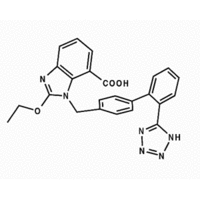Although outcomes in patients with chronic heart failure (CHF) have improved recently because of the increasingly widespread use of beta blockers and angiotensin-converting enzyme (ACE) inhibitors, patients remain at increased risk of hospital admission and cardiovascular death. In addition, CHF is the main reason for hospital admission in older adults, and its significance is expected to increase as the population ages. In the search for improved therapies for CHF, angiotensin II type 1 receptor blockers (ARBs) could prove valuable, especially in patients who cannot tolerate ACE inhibitors. Pfeffer and colleagues reported the results of large international trials of the ARB candesartan in patients with CHF in the Candesartan in Heart failure Assessment of Reduction in Mortality and morbidity (CHARM) study.
They studied adult patients at 618 sites in six countries who had symptomatic CHF of New York Heart Association (NYHA) class II to IV of at least four weeks' duration. Patients with limited two-year survival were excluded from the study. Exclusion criteria included the following conditions: elevated levels of serum potassium or creatinine; bilateral renal artery stenosis; hypotension; recent myocardial infarction (MI); cardiac surgery, or stroke; or use of an ARB within the previous two weeks. Eligible patients were assigned to different studies based on left-ventricular ejection fraction (LVEF) and experience with ACE inhibitors. Patients with LVEF greater than 40 percent formed the CHARM-Preserved group, while patients with 40 percent or lower LVEF who were being treated with an ACE inhibitor were assigned to the CHARM-Added group, and those with 40 percent or lower LVEF who were not receiving an ACE inhibitor because of previous intolerance were assigned to the CHARM-Alternative group.
All patients were assigned randomly to treatment with candesartan or placebo. Starting dosages of candesartan were 4 mg or 8 mg daily, and the dosage was increased as tolerated to a target dosage of 32 mg daily. Once the drug dosage had been titrated, patients were followed every four months for at least two years. Use of conventional CHF therapy continued during the study at the physicians' discretion. Although overall mortality was the primary outcome, other outcomes monitored included cardiovascular death, hospital admission for CHF, MI, stroke, cardiac revascularization procedure, and new-onset diabetes.
The 3,803 patients treated with candesartan and the 3,796 given placebo were comparable in all important respects. During the median 37.7 months of follow-up, 886 candesartan-treated patients (23 percent) and 945 placebo-treated patients (25 percent) died of any cause. This lower rate of mortality among patients treated with candesartan was attributable to fewer cardiovascular deaths (691 [18 percent] compared with 769 [20 percent] in the placebo group), particularly during the first year of treatment.
Hospital admissions for CHF were reduced significantly in candesartan-treated patients (1,454 compared with 2,010 placebo-treated patients) and significantly fewer candesartan-treated patients had two or more admissions for CHF (9 percent compared with 12 percent for placebo). The overall reduction in risk of death or hospital admission with candesartan treatment was similar in men and women and was equivalent in the 1,736 patients 75 years or older compared with the younger patients. Effectiveness also was similar in patients with LVEF above or below 40 percent, across all NYHA classes of CHF, and irrespective of the presence of diabetes. By six months, 63 percent of patients in the candesartan group had achieved the target dosage, but 11 percent had discontinued the medication compared with 7 percent of patients who had discontinued placebo. By the end of the study, 23 percent of candesartan-treated survivors and 19 percent of placebo-treated patients had discontinued the medication. Laboratory abnormalities were the most common reasons given for discontinuation.
The authors conclude that candesartan therapy is associated with a small but significant reduction in overall death and hospital admission in patients with CHF, regardless of previous treatment or ejection fraction.
ANNE D. WALLING, M.D.
Pfeffer MA, et al. Effects of candesartan on mortality and morbidity in patients with chronic heart failure: the CHARM-Overall programme. Lancet September 6, 2003; 362:759-66.
EDITOR'S NOTE: When The Lancet publishes four individual "fast-track" articles and a commentary (1) on the results of a single study, a major shift in therapy is underway. In addition to the above "overall" study, articles have been published on the subgroup of patients with preserved ventricular function, and two articles were published on subgroups with reduced ventricular function (one group intolerant of ACE inhibitors and one group tolerant). In all cases, significant but sometimes modest benefits were obtained, and adverse effects were documented. A summary of this rather overwhelming wealth of information concludes that over three years, ARB therapy prevented one death per 63 patients treated, one hospitalization per 23 patients treated, and one new case of diabetes per 71 patients treated. The author recommends adding ARBs to optimal current therapy (i.e., ACE inhibitors, beta blockers, possibly spironolactone) in patients with CHF who have ejection fractions of 40 percent or less. Use of ARBs also is recommended in patients with CHF who are intolerant of ACE inhibitors. In patients with CHF who have ejection fractions greater than 40 percent, the modest risk reduction must be considered against adverse effects, tolerability, and other factors on an individual basis.
Even the apparently small gains in these patients should not be disregarded. Heart disease is the most common cause of death in the United States, accounting for more than 700,000 deaths annually. With numbers of this magnitude, even a 1 to 2 percent reduction in the rates of death or hospital admission saves 7,000 to 14,000 lives and potentially makes meaningful savings in suffering and health care costs. Many more studies and much more information on these drugs and other treatments for CHF are anticipated as we continue to "fine tune" therapies for this diverse group of patients.--A.D.W.
REFERENCE
(1.) White HD. Candesartan and heart failure: the allure of CHARM [Commentary]. Lancet 2003;362:754-5.
COPYRIGHT 2004 American Academy of Family Physicians
COPYRIGHT 2004 Gale Group



